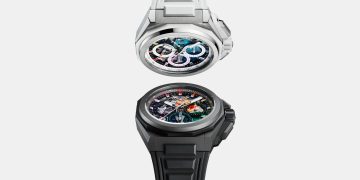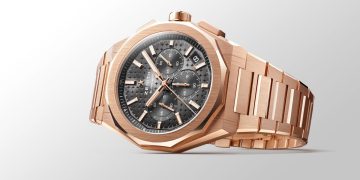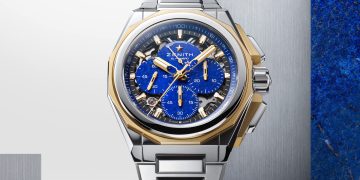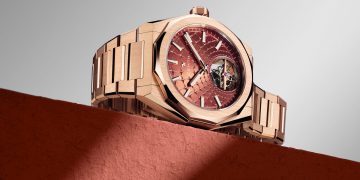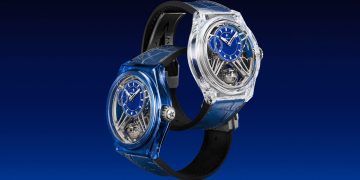Source: Images and content by A Collected Man @ ACollectedMan.com. See the original article here - https://www.acollectedman.com/blogs/journal/lange-1-modern-icon
Introducing a new watch to the market is never an easy thing. Within an industry steeped in tradition, it’s a daunting prospect for any manufacture, no matter how many years the brand has been around for. There was a lot of pressure on the release of the Lange 1 in 1994, along with its three sibling models. The model was charged with resurrecting a name that had been ravaged by war in Europe and laid dormant for decades behind the Iron Curtain. At a time when the Swiss watch industry was doubling down on larger watches and the idea of a luxury mechanical watch was only just reappearing in the wake of the Quartz Crisis, A. Lange & Söhne were attempting to establish a new base for horology in Saxony. Now recognised as one of the hubs of watchmaking in Europe, the Lange 1 has a lot to answer for.

The geometry behind the ever-recognisable design.
We wanted to shine a light on the origins of this watch, looking at the history of the brand it helped revive, as well as the design that took four years to shape. Having remained relatively unchanged for the past two and a half decades, it is slowly cementing itself as a modern classic. What we hope to convey in this article is how the Lange 1 helped to move the needle of the watch world. Whether it be from a design perspective, reviving an interest in asymmetrical pieces, or reintroducing the idea of high-quality German watchmaking to a new generation of collectors, there’s endless details to get lost in. This would seem to be a lot for any one watch to accomplish, yet the Lange 1 would appear to be something of an over-achiever.
The Rebirth of A. Lange & Söhne
The name Lange has been tied to watchmaking and the Saxony area of Germany for centuries. The story of the Lange 1 cannot be told fully without first going back to the very beginning of the brand, in the 1800s. Ferdinand Aldoph Lange – which is where the “A” in A. Lange & Söhne comes from – began his watchmaking journey under the tutelage of master watchmaker, Johann Christian Friedrich Gutkaes. It was while apprenticing with Gutkaes that the young Lange would help construct a five-minute clock with a digital display that lives above the stage of the Dresden Opera House. The innovative design of this clock would come to have a big impact on the design of Lange watches, later produced in modern times.
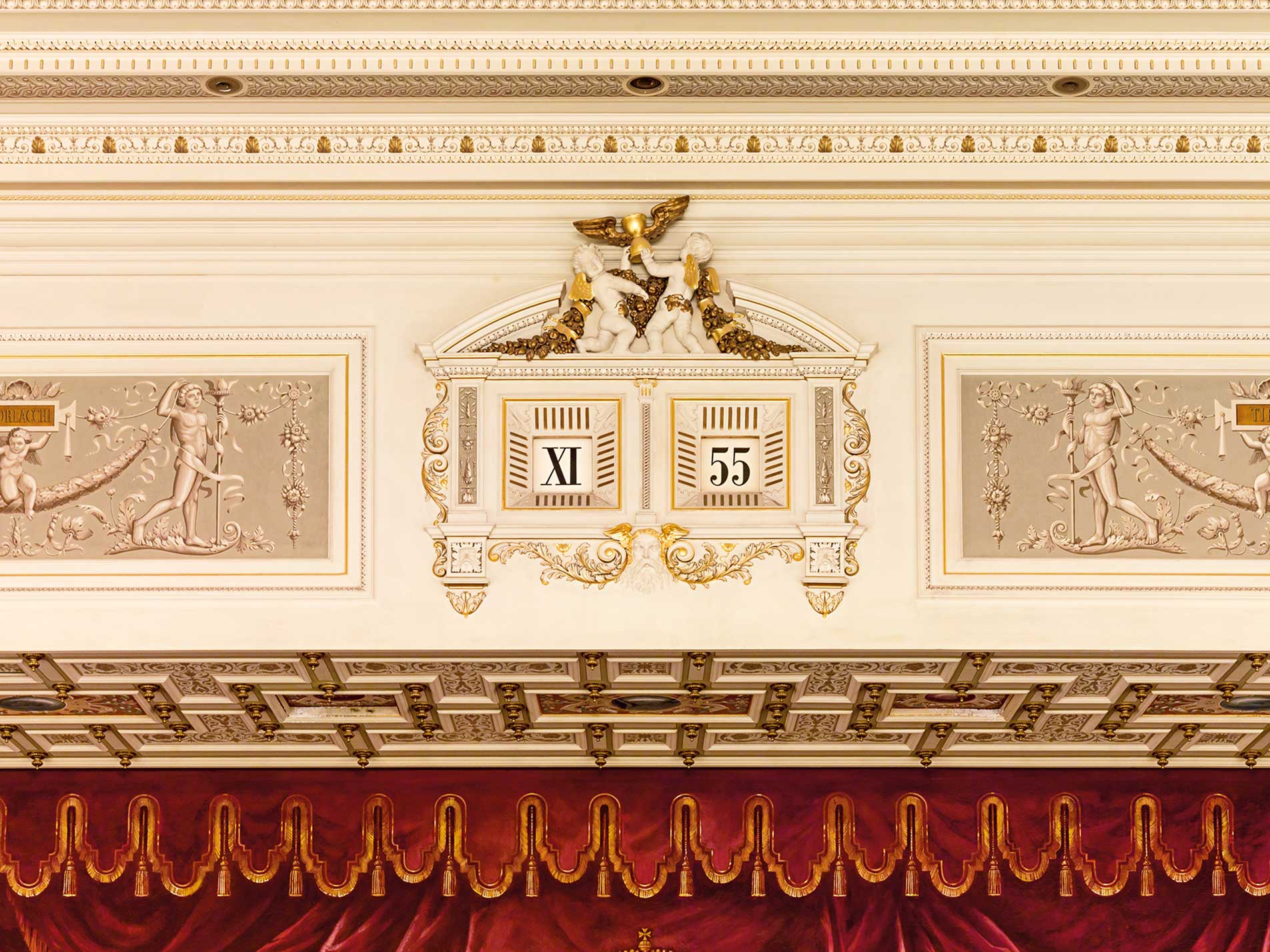
The digital display clock that a young Lange would help install, courtesy of A. Lange & Söhne.
Lange studied in Paris, before returning to Dresden to marry the daughter of his former master and begin work on establishing his own manufacture. At this time, the centres of the watchmaking world resided firmly in England and France, such that making a name for yourself outside of these hubs, only added to the difficulties of starting a new business. Not only was Lange hoping to establish a new watch company outside of the traditional areas, but he was also planning to make high-end watches in the impoverished town of Glashütte. It was a town which he would later become mayor of for 18 years, developing the city around the watchmaking industry which he had helped create.
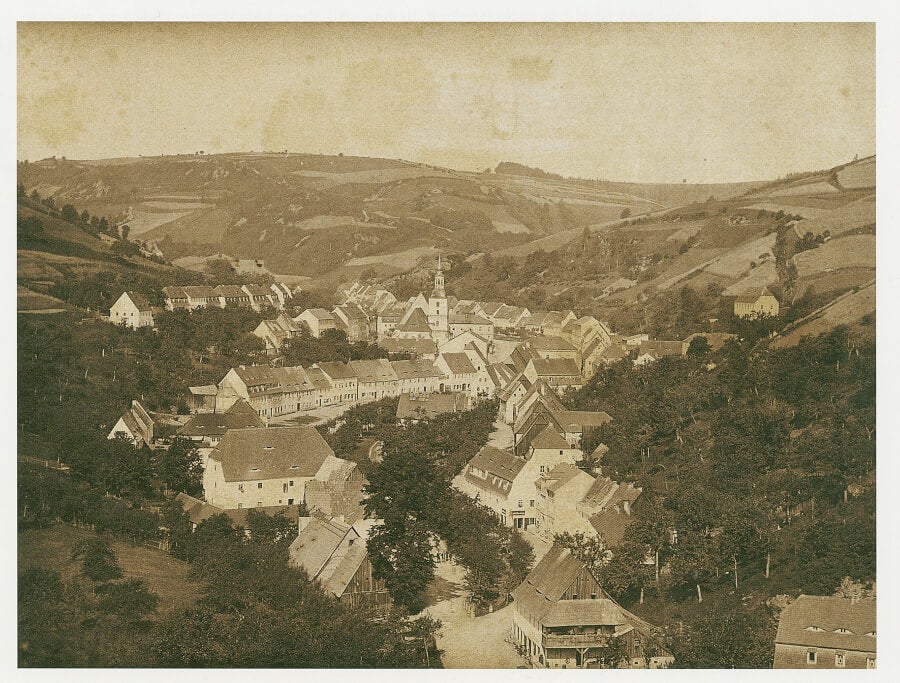
The town of Glashütte around the late 19th century.
In his new workshop, Lange begins to innovate, with one of his most lasting additions to the watch world being the three-quarter base plate. This contribution is still visible today in the modern pieces from A. Lange & Söhne, as well as those from many other German brands that have sprung up in the last 150 years. As the years moved on, and the company was passed down from father to söhne, the Lange name became established, not only in Saxony but further afield. Their complex chiming pocket watches and accurate chronometers, started to raise the company’s profile worldwide.
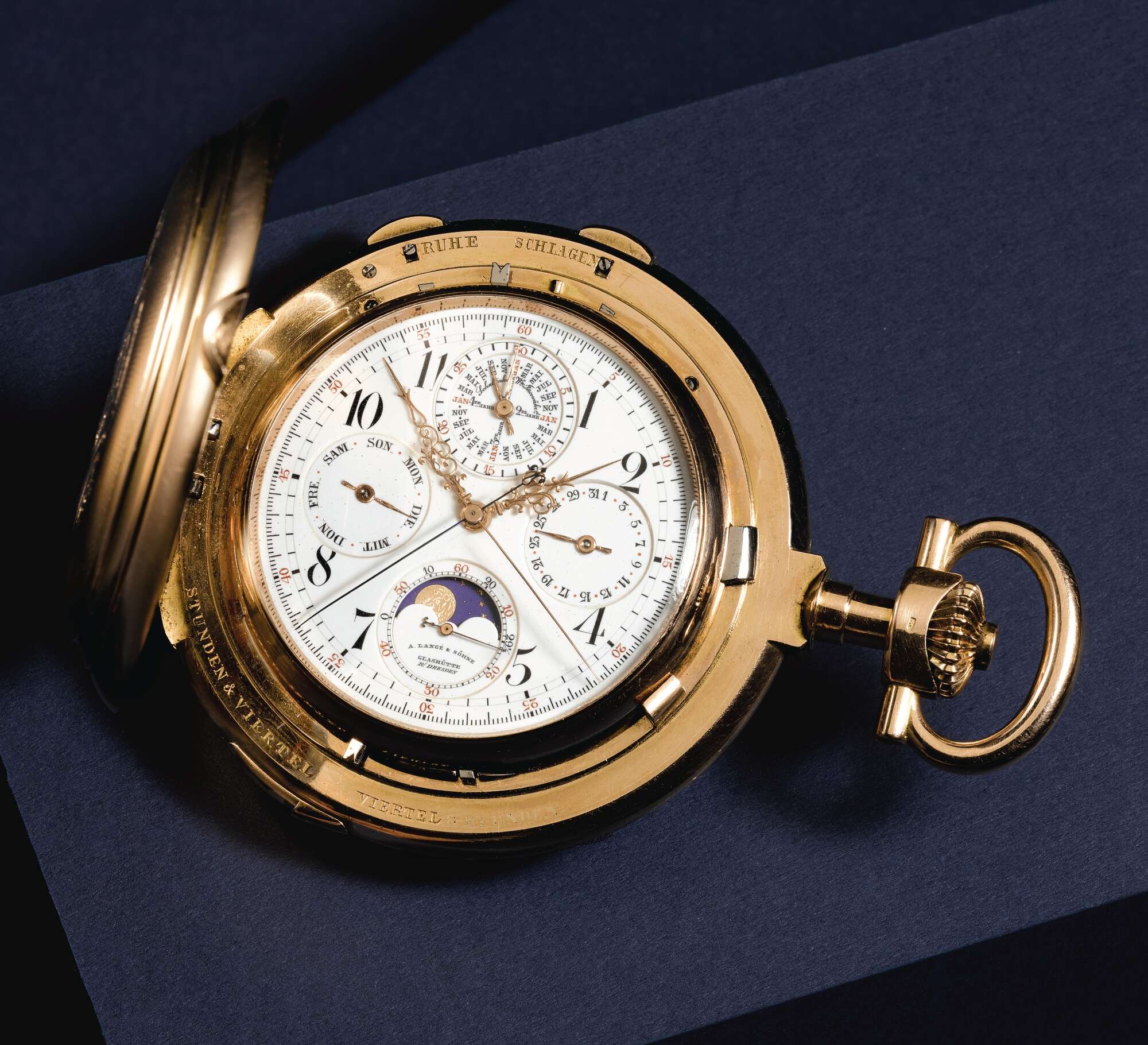
A Grand Complication pocket watch made by A. Lange & Söhne in 1901, courtesy of Sotheby’s.
While all seemed to be going well for the watchmakers, their luck was about to turn. Caught up in the turmoil caused by World War One, the financial crash of 1929 and World War Two, the first half of the 20th century was not kind to the brand. During the Second World War, they were put to task producing oversized pilots watches for the German forces. In the final months of the conflict, disaster struck as their factory was bombed and all of their manufacturing capabilities were destroyed.
Due to their geographic location, after the war, they were put under the rule of the Soviet Union. Falling firmly behind the Iron Curtain meant that the company was nationalised for the next 45 years, essentially spelling the end of the A. Lange & Söhne name. It would take the collapse of the Soviet Union and the fall of the Iron Curtain to bring this company back, but it wasn’t as simple as that.
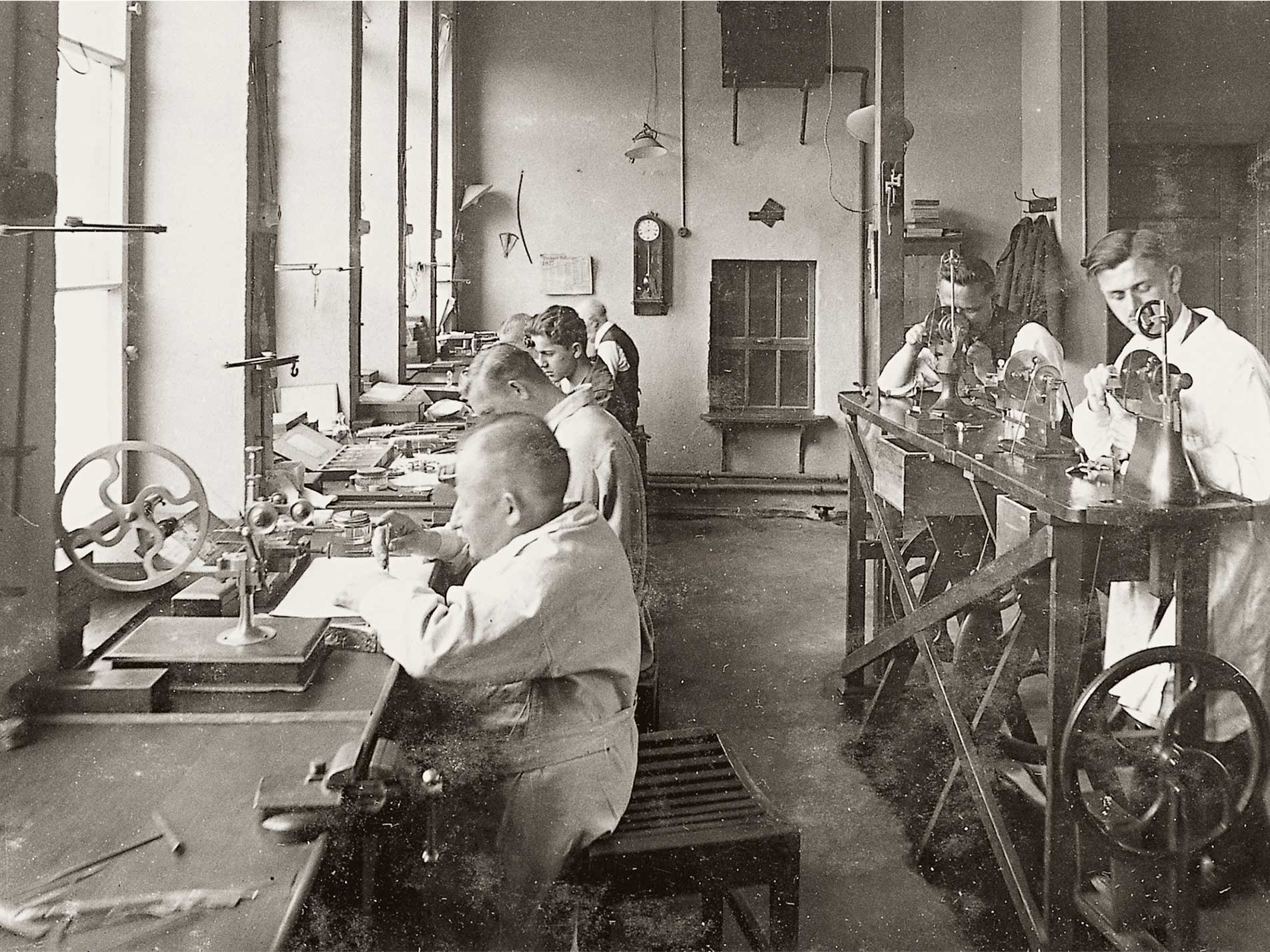
Inside an A. Lange & Söhne workshop before the end of the World War Two, courtesy of A. Lange & Söhne.
As many may already know, the company of A. Lange & Söhne that we know today was founded by the great-grandson of Ferdinand Adolph Lange, Walter, and watch industry veteran, Günter Blümlein. Blümlein, a Nuremberg native who grew up in post-War Germany, oversaw the resurgence of IWC and Jaeger-LeCoultre in his role as CEO of LMH. It is believed that as soon as the Berlin Wall came down, he reached out to the surviving member of the Lange family, Walter, and asked him to help revive his ancestral business. This was after Walter had attempted to bring the Lange name back to life a couple of times and failed. So, in 1989, Blümlein invited Walter back to Glashütte where he hadn’t lived and worked for almost 40 years, but where the Lange name was still remembered.
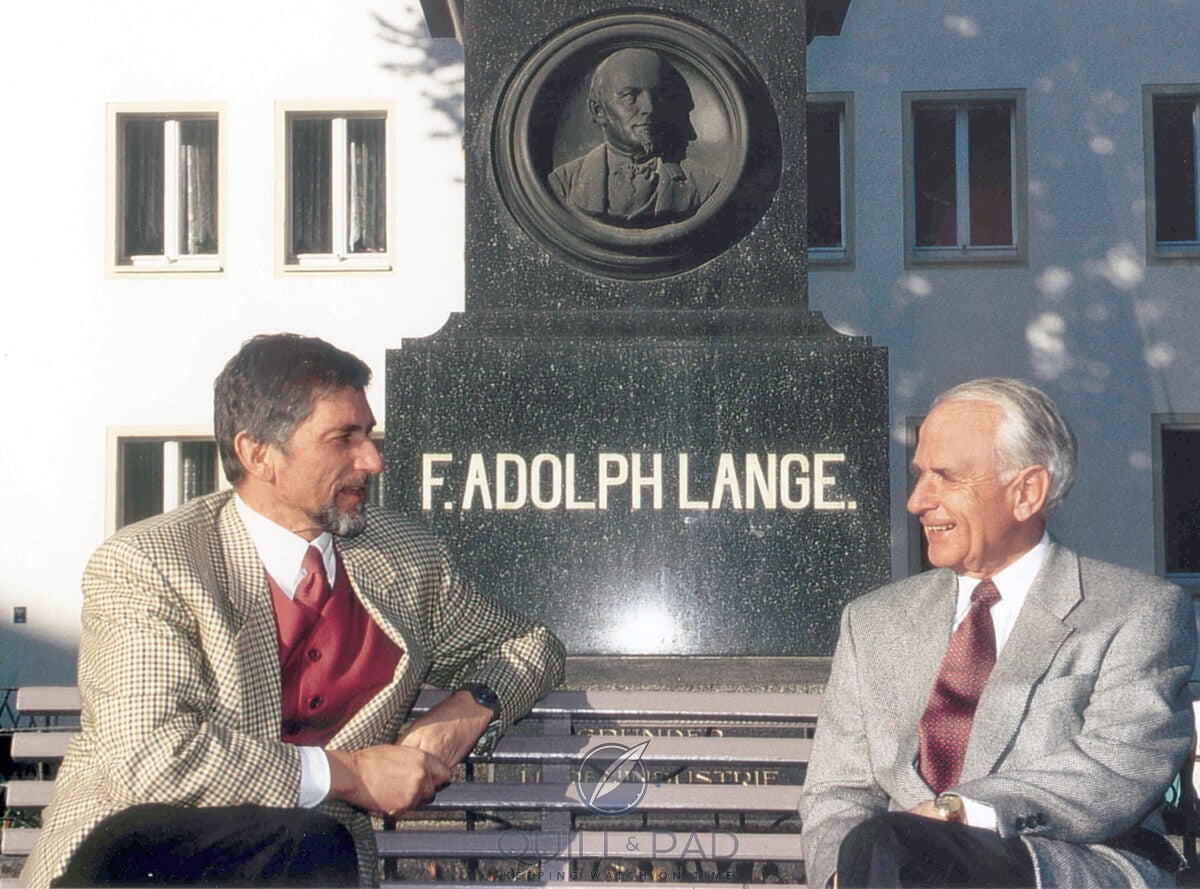
Günter Blümlein and Walter Lange sat in front of a memorial to Walter’s great-grandfather, Ferdinand Adolph Lange, courtesy of Quill and Pad.
It was the 7th December 1990 when Walter Lange officially founded his new company, Lange Uhren GmbH in Glashütte, an auspicious date as it was the exact same date that his great-grandfather had founded the original A. Lange & Söhne, over 100 years prior. This started the four-year journey that Lange and Blümlein would go on with their small team to bring the company back from the ashes, with the release of their first four models on the 24th October 1994. “The introduction of Lange Uhren GmbH changed the perception of Germany as a watch producing country,” Stefan Muser, CEO of Dr. Crott Auctioneers, explained. As he points out, “it’s interesting since Germany used to be a major player in the ‘business’ from the beginning of the 15th century.”
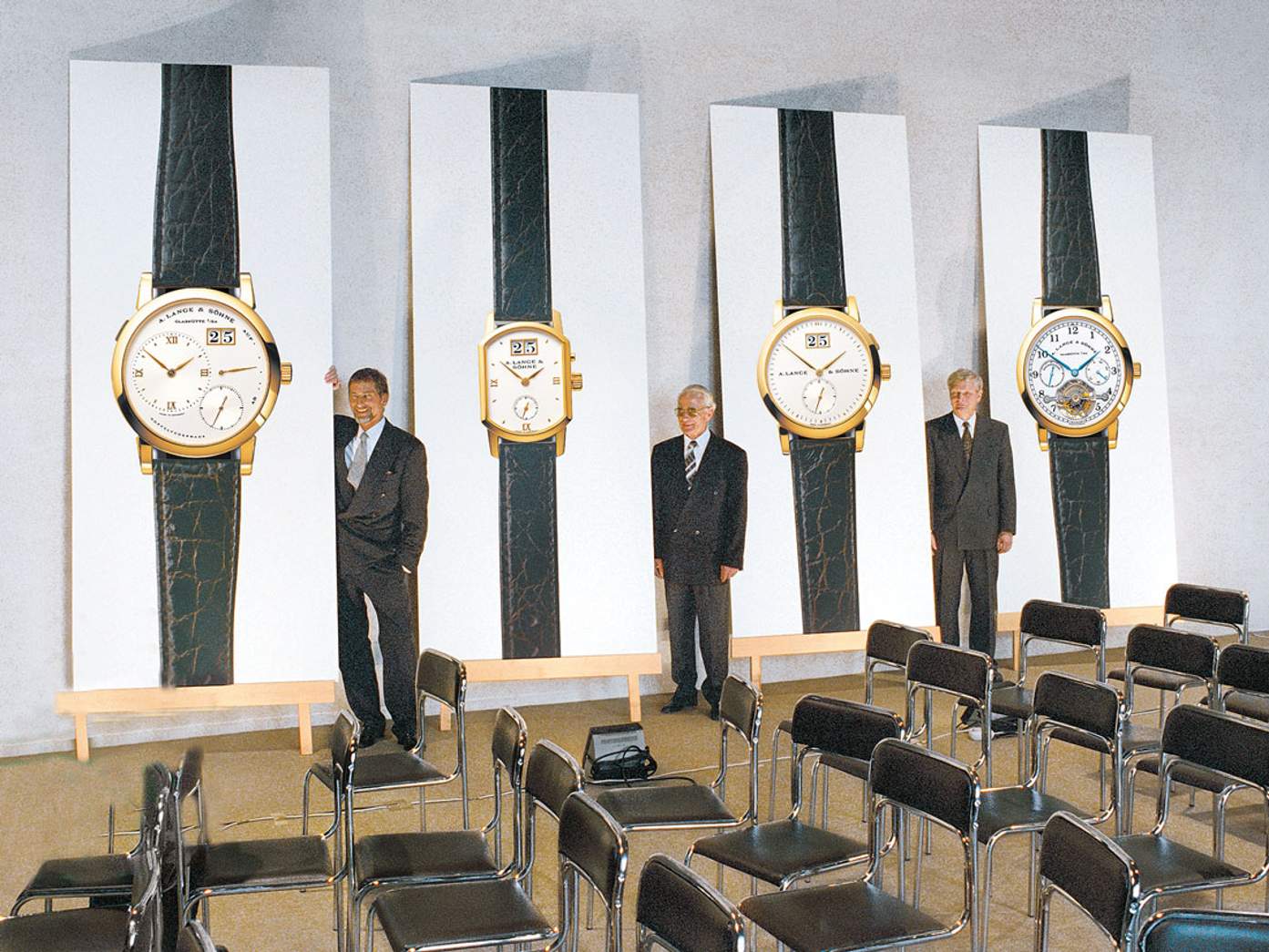
The press conference where the brand was relaunched.
The Arkade, Saxonia, Tourbillon Pour le Mérite and the Lange 1, were powered by three different calibres, with the Arkade and Saxonia sharing the same one. They were produced in a total of 123 examples, which were distributed to 12 retailers in Switzerland and Germany, with the final ones being allocated by pulling straws, as all the retailers wanted as many as they could get. Before we move on to focus on the Lange 1, there’s an interesting anecdote that goes to show Blümlein’s foresight and marketing ability. The watches were released to the press on the 24th, yet all the watches on display and in the marketing materials had their dates set to the 25th. This was because Blümlein knew that the images wouldn’t be shared until the next day and wanted them all to show the correct date. Even today, all Lange watches will display the 25th in recognition of this decision.
Why the Lange 1?
For many, the Lange 1 is the quintessential A. Lange & Söhne watch, and by extension the purest form of German design in watchmaking. As Alp from Langepedia puts it, “the Lange 1 is the symbol of the rebirth of German watchmaking.” However, how did it get to this level of notoriety and what are the features that make it stand out? To answer this, it makes sense to break down the watch into the various components and see how, combined, they helped move the needle of German watchmaking. As Muser told us, “the design was somehow fresh and fascinating to the wristwatch world. It was both traditional and unconventional. It was never boring”
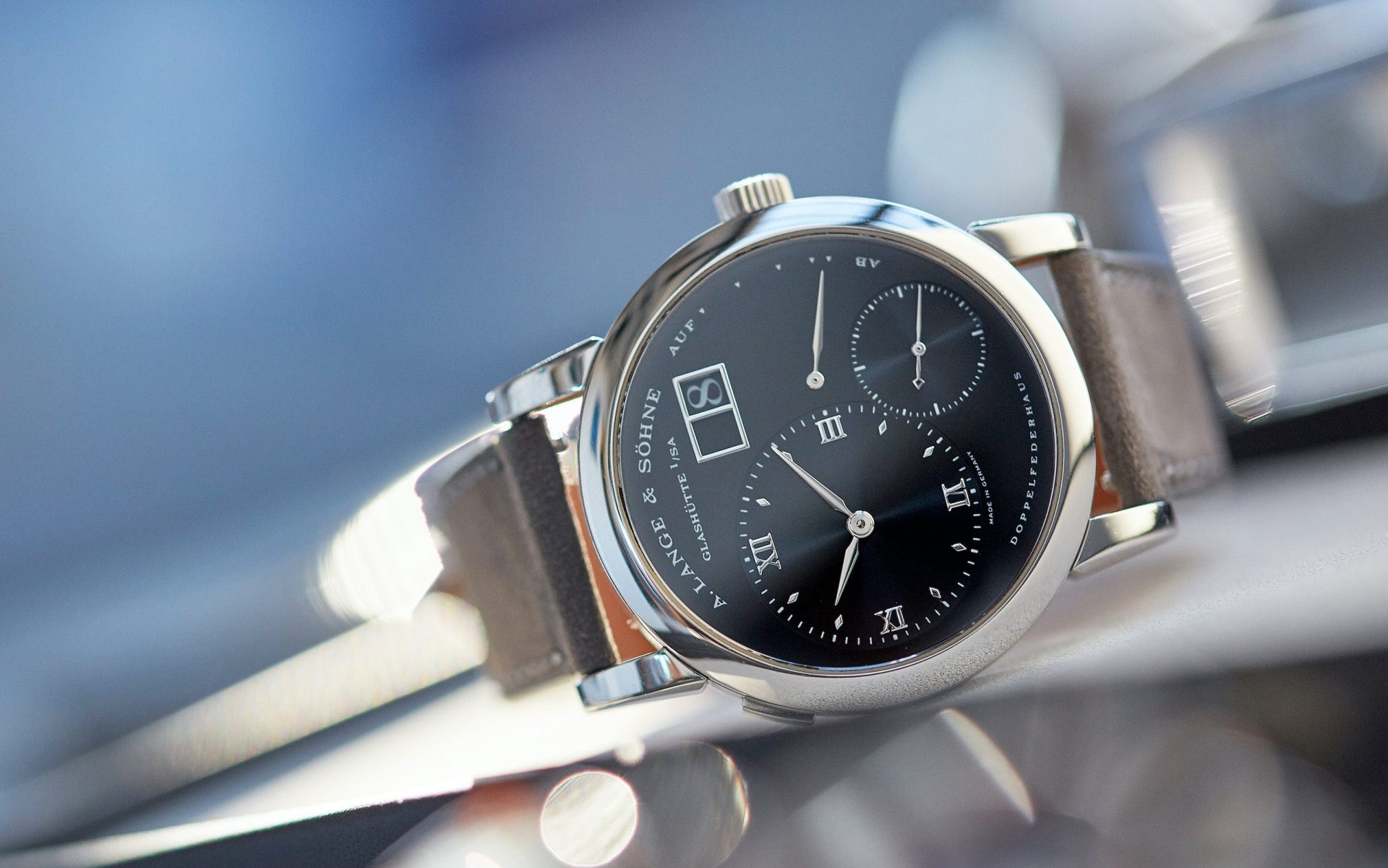
The carefully considered dial design shown here on a “Darth”.
The first thing which needs addressing is possibly the defining characteristic of many Lange watches, the oversized date. It was fitted to three of the original four models and has been copied by many other manufactures since, especially those also based in Germany. Reaching back into its history, this design choice was directly inspired by the five-minute digital display clock that Ferdinand Adolph Lange helped to install above the stage of the Dresden Opera House. Mechanically, installing a large date window on a watch, without seriously compromising on thinness, is not the easiest of tasks. While the Lange 1 is by no means an ultra-thin watch, the integration of the large date display didn’t significantly alter the proportions of the timepiece.
Design-wise, the measurements of it were carefully considered, meeting the exacting standards of the Golden Ratio. This helps make the date window, one of the most complained about aspects of watch design, into something which is intrinsically pleasing and doesn’t come across as an afterthought. Possibly one of the most carefully considered date windows on the market at that time, it solved the problem that Rolex tried to fix with their cyclops, namely legibility. Another important characteristic of the date window is that its size does not overpower the rest of the dial, where dead space is used to great effect.
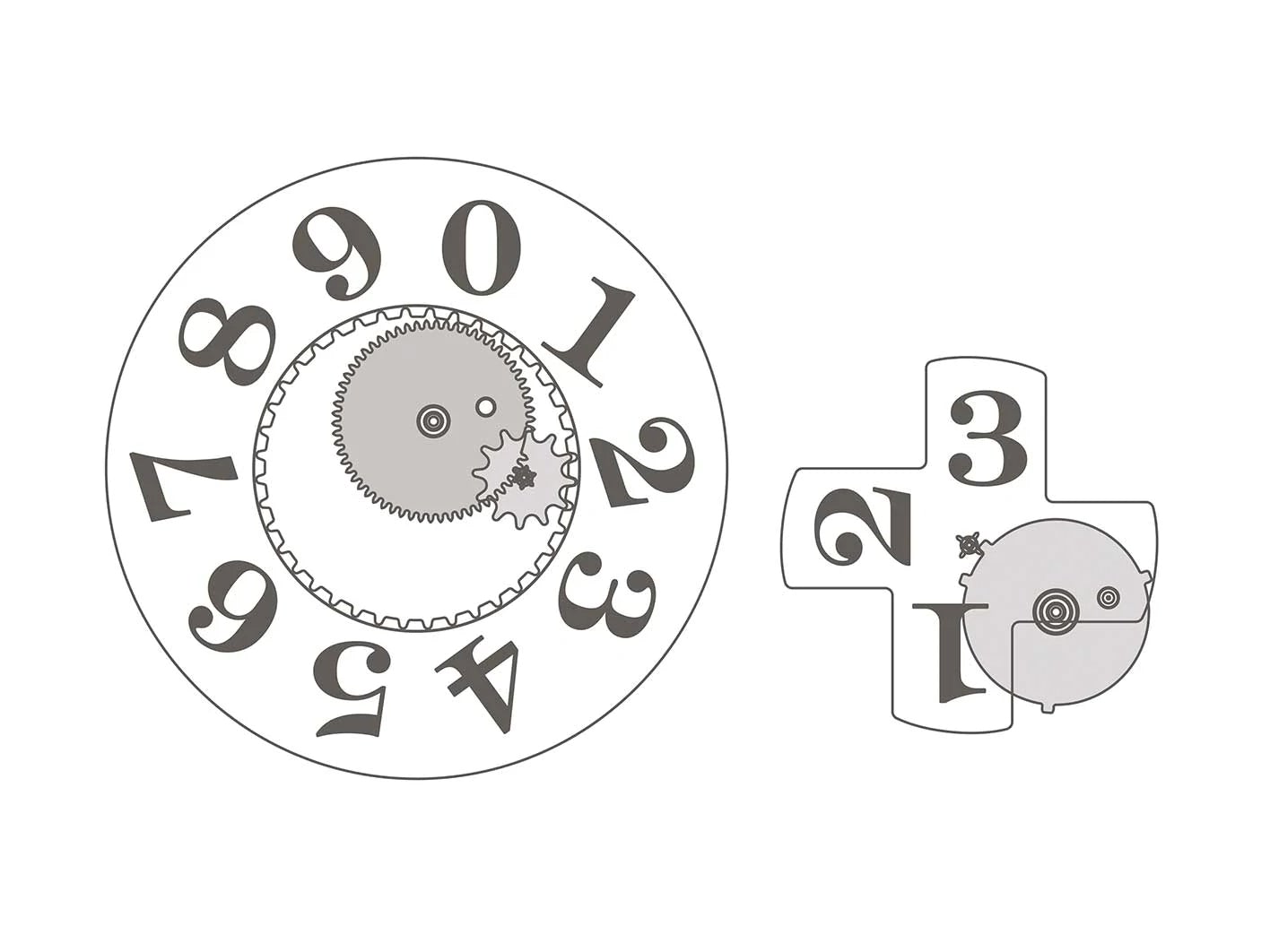
The mechanism that makes the oversized date possible.
While the use of the Golden Ratio is important to Lange’s design overall, and not just the date window, according to Anthony de Haas, Lange’s Director of Product Development, it is not the limit of their aesthetics. While speaking with Time and Tide, he pointed out that, “we understand the importance of the Golden Ratio, but while we look at it, we don’t work with calculations to achieve it. It’s a question of how it is to the eye.”
The next feature which should be highlighted is the placement of the various components on the dial itself. This asymmetrical element has come to define this model and the family of watches that it’s generated. However, it’s not just random placement. According to Alp, “it took them countless different combinations and positions before they finally landed on the final design.”
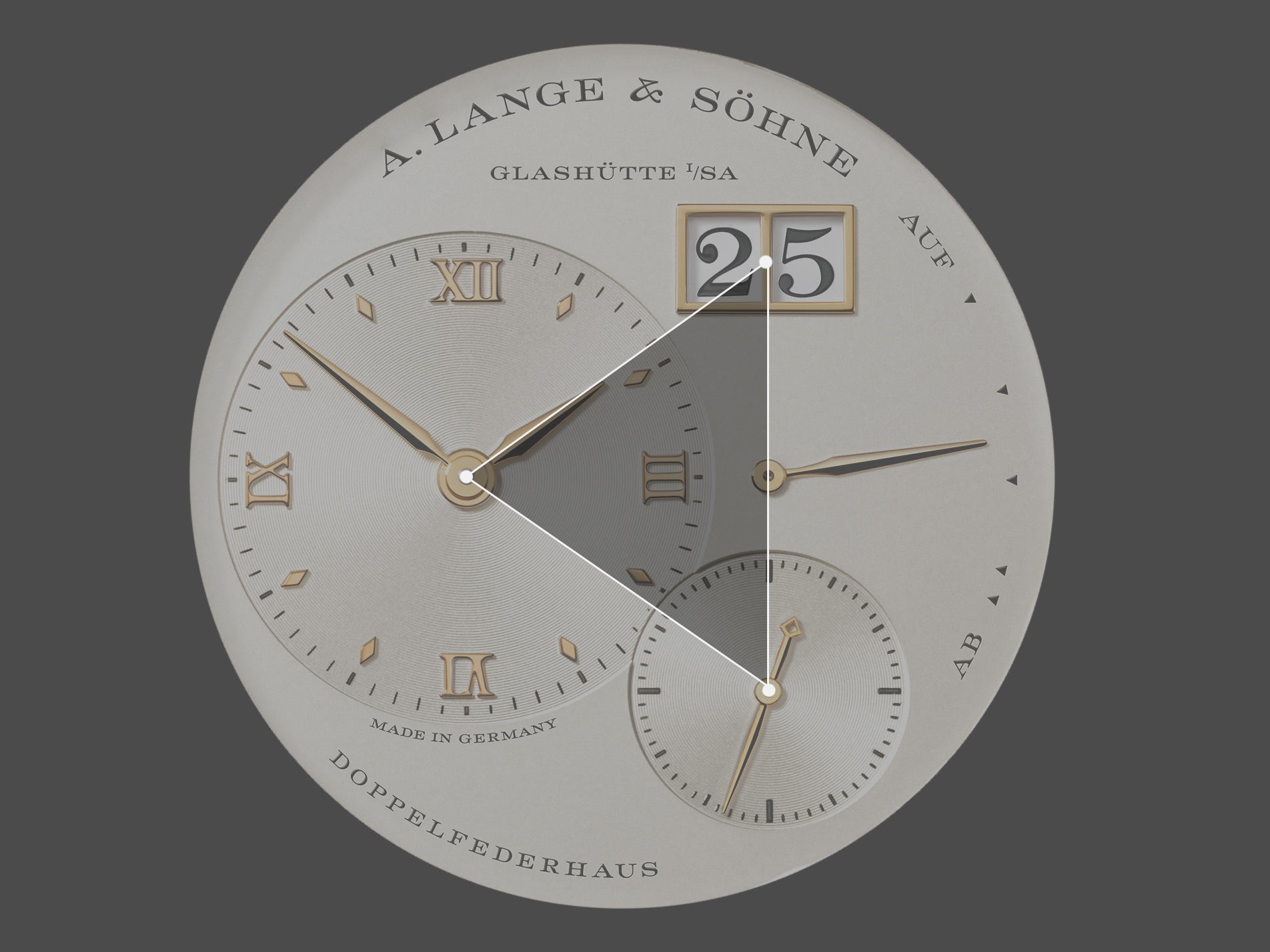
The perfectly calculated dial placement.
You will find plenty of people praising this design as visionary of ground-breaking, when it actually relies heavily on basic mathematics. By following a few simple geometric rules, Blümlein and his team were able to fit all of the various components in place without having any disruptive overlap or squashed lettering. In the process, they made sure that each part of the dial not only conveys the information it needs to clearly, but that it also does so in an aesthetically pleasing way. While a watch might be sold on the basis of its good looks, it will never stick around for long, if it’s not also functional. Seeing as the Lange 1 has hardly changed cosmetically in over 25 years, it could safely be assumed that it achieves both beauty and function.
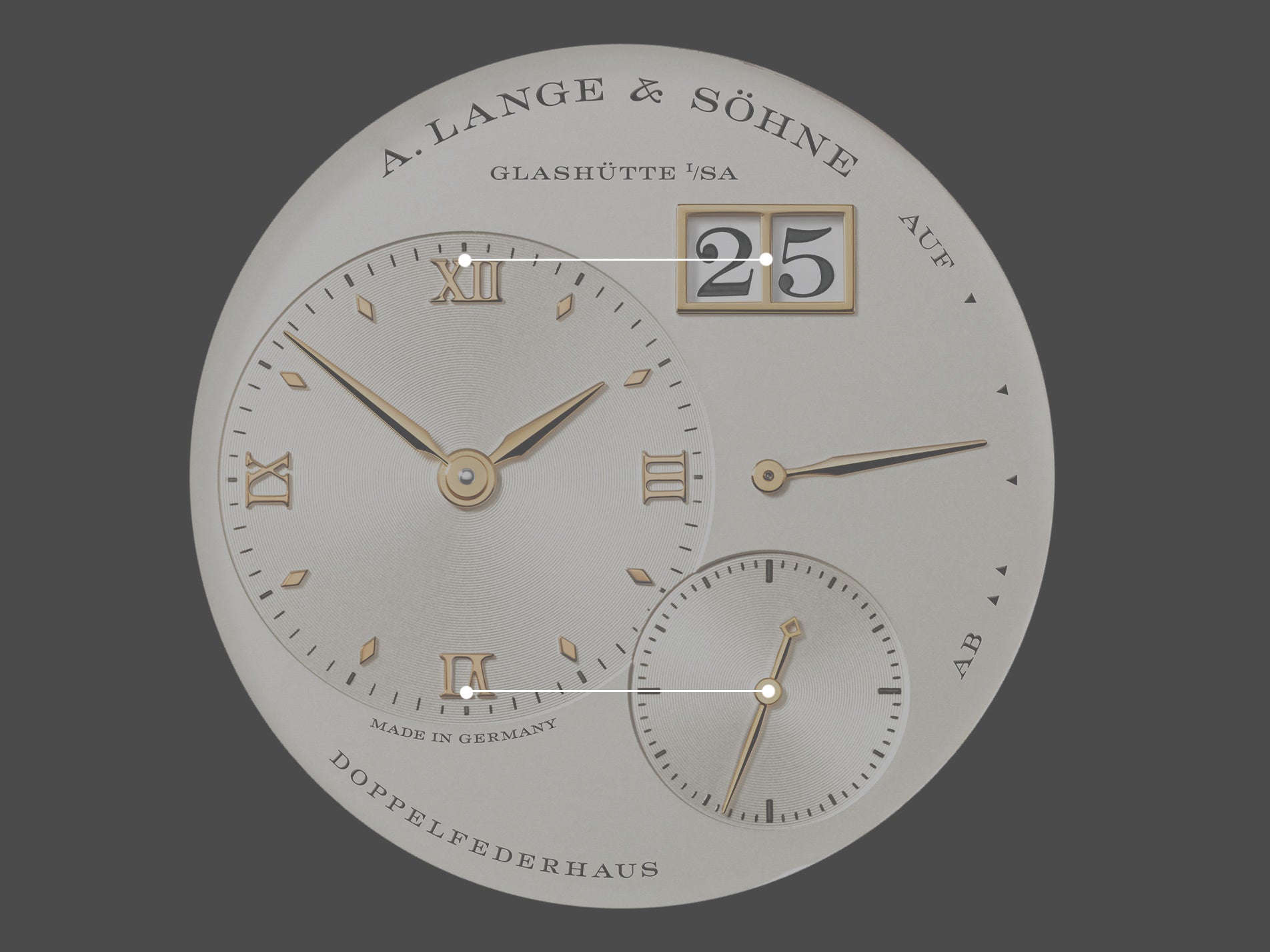
They made sure everything was in line.
As an example of this, let’s take a brief look at the top and bottom of the Roman numerals from the
hour and minute sub-dial. The top of the “XII” falls perfectly in line with the centre of the large date and the bottom of the “VI” aligns with the centre of seconds sub-dial as well. If you combine this with the fact that the centres of the two sub-dials and date window form an isosceles triangle, you end up with a dial that never appears unbalanced.
To finish it off, the dial is partially encircled by text at the top and bottom, as well as the power reserve indicator, all following the curve of the case. One fact about the power reserve indicator, that Alp was keen to point out, is the spacing between the triangles used as markers. This was another idea from Blümlein, designed to keep the manual movement fully wound, in order to achieve peak performance over time. “The watch has three days of power reserve which are indicated by these five triangles. After a full wind, it will take about a day and a half for it to reach the bottom two markers. It will then take another day and half for it to be fully unwound.” However, at the end, the hand will only move a fraction of what it did before. This distortion between the first and second half of the power reserve tricks the wearer into winding it more often, thus keeping the movement at its most accurate stage.
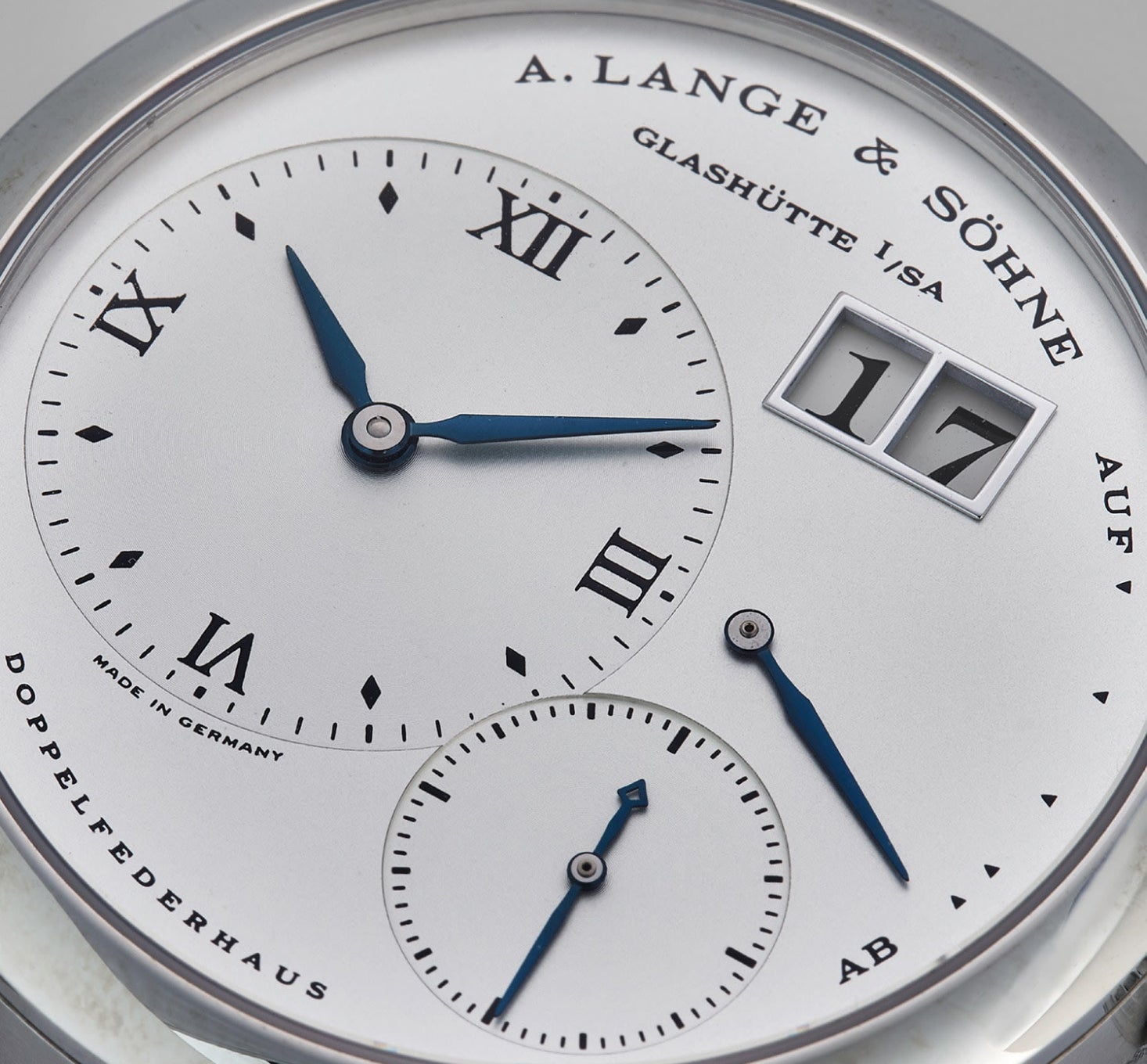
The curious, uneven power reserve of an early Lange 1, courtesy of Phillips.
We also wanted to briefly discuss the lettering and typeface that Lange employed for its relaunch. This was an aspect that they took particularly seriously in the four-year run up to releasing their first watches. A lot has been written about this already, especially by the likes of Larry Peh of &Larry and SJX. While we won’t be able to go into as much detail as these two have, we wanted to highlight a few key points, which we feel make the Lange 1 stand out from its peers.
The typeface that Lange use for their dials is known as Engravers. It was invented by a German typeface designer by the name of Robert Wiebking in 1899, taking its inspiration in the work of copperplate and steel plate engravers from the 19th century. Bold, with razor sharp serifs, this is a remarkably traditional and conservative lettering choice, which helps to anchor A. Lange & Söhne to its historical roots through its design. The fact it was designed by a German also makes this a conceptually sound choice for the brand.
Whilst Lange did adopt this style for all writing and numbers on their dials, they did make a few tweaks to the original, notably by broadening certain parts to make it more legible, whilst also ensuring that it would still hold up when shrunk down to the size needed for a watch dial. They also added extra sharp corners to the serifs, not something that is easy to see with the naked eye, but a nice nod to 19th century lettering and Lange’s engraving heritage, according to Peh.
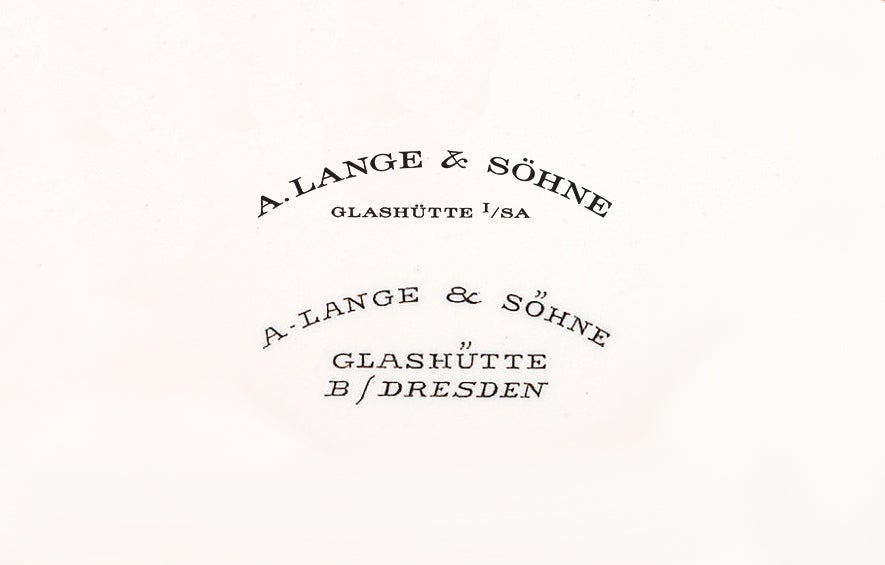
Above is the modern wordmark crafted by Blümlein and below is the one used by the company in the 19th and 20th centuries.
One of the most dramatic and distinctive stylistic choices that Lange made when designing their first modern line was the ampersand in their wordmark. Whilst it would have been possible for them to copy how Lange had applied their wordmark to dials in the past, that could’ve looked somewhat incongruous. They did keep the overall curved style but managed to clean it up so that it now fell in line with the rest of the sharply designed dial. The most detailed examination of this ampersand comes from Peh, who argues that its unique character comes from an amalgamation of various Engravers faces designed in the early 20thcentury. He has also managed to point to a reason for this choice. Flattening the top of the ampersand helps to keep the height of all the characters uniform, thus creating a uniform curve at both the top and bottom of the wordmark. Or as Peh puts it, “preserving the geometric integrity of the dial.”
It seemed only right that we look at the case next, after discussing the dial in such detail. Possibly one of the more unique aspects of the Lange 1 case is the lugs. Supposedly designed by Blümlein himself, they are formed separately from the case, with inner facets that help add an angular nature to them that only increase their sharpness. It’s believed that Blümlein took a file and made the inner angles on the lugs of the brass prototype case himself; yet another attempt to make these watches standout from all of the Swiss made pieces on the market.
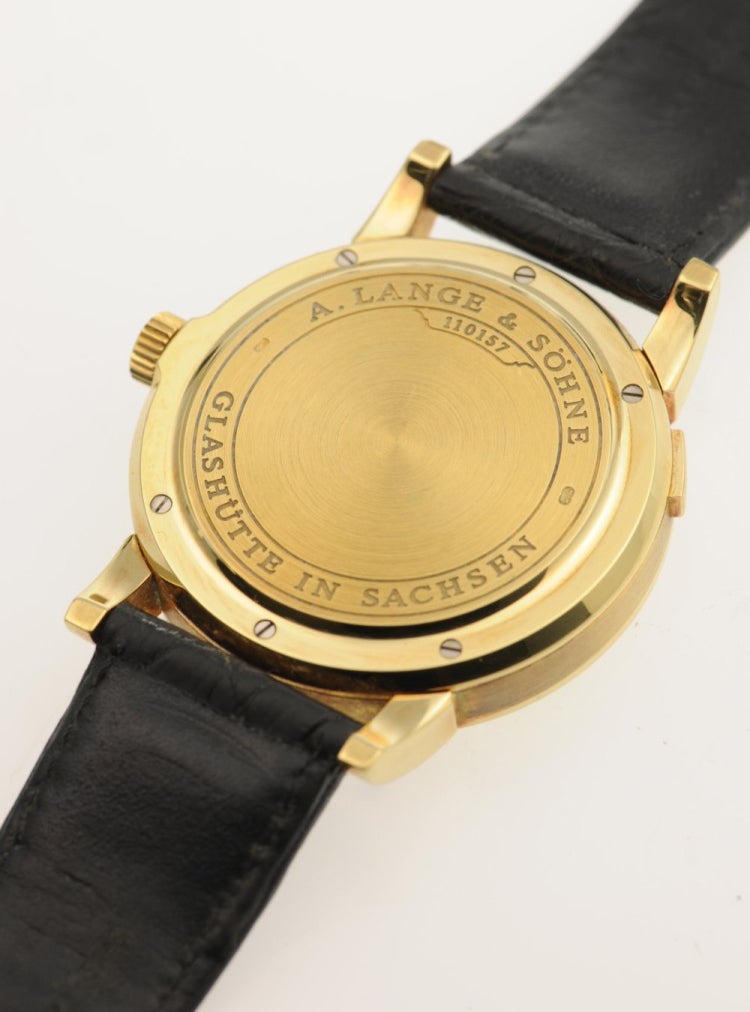
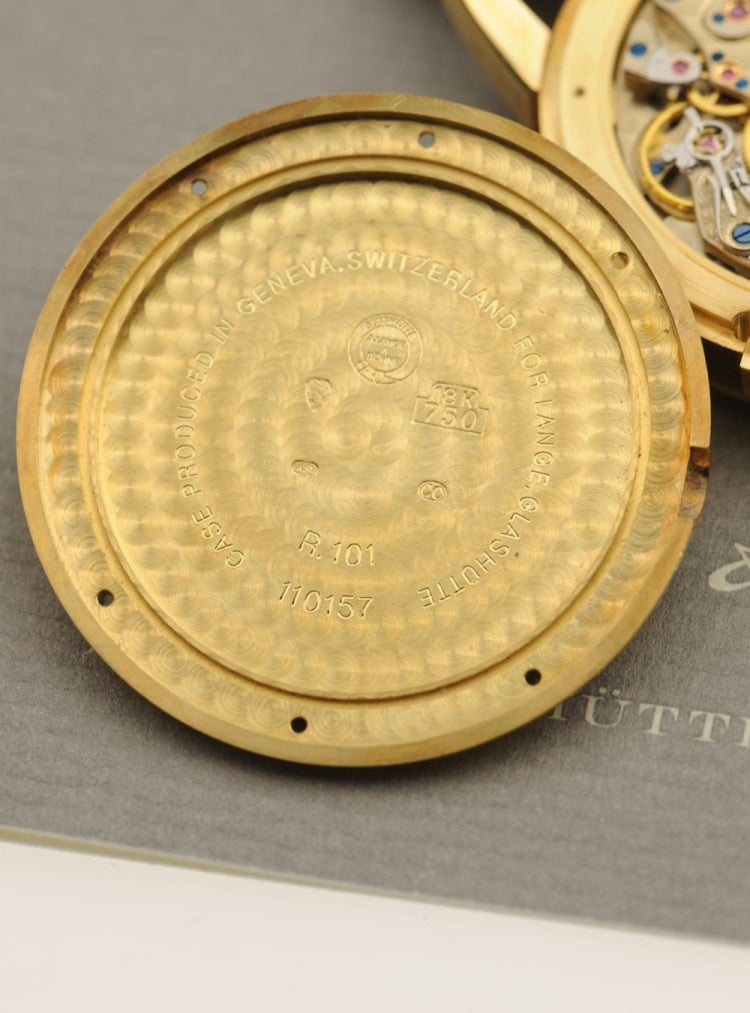
An early closed caseback and the engraving that can be found inside them, courtesy of Dr. Crott Auctioneers.
Another important element of these early cases is found on the back. The original batch had closed casebacks, as this was seen as more in keeping with tradition at the time. Despite having the movement sealed off, it was still finished to an extremely high standard, with the ever-recognisable hand engraved balance cock. It wasn’t until the initial feedback from collectors came in that this was changed to a sapphire caseback for the second generation released a year later.
Speaking of the movement, there are a few key things to note when looking at the early models in particular. The first movement installed in these watches was Lange’s caliber L901.0, based on a Jaeger-LeCoultre caliber 822 gear train that Blümlein brought over. One of the many things that helped to cement this movement as a German, and not a Swiss one, was the use of untreated German silver. This metal not only gave the movements a unique shine, but over time they can start to develop a much richer hue that is distinct to the brand.
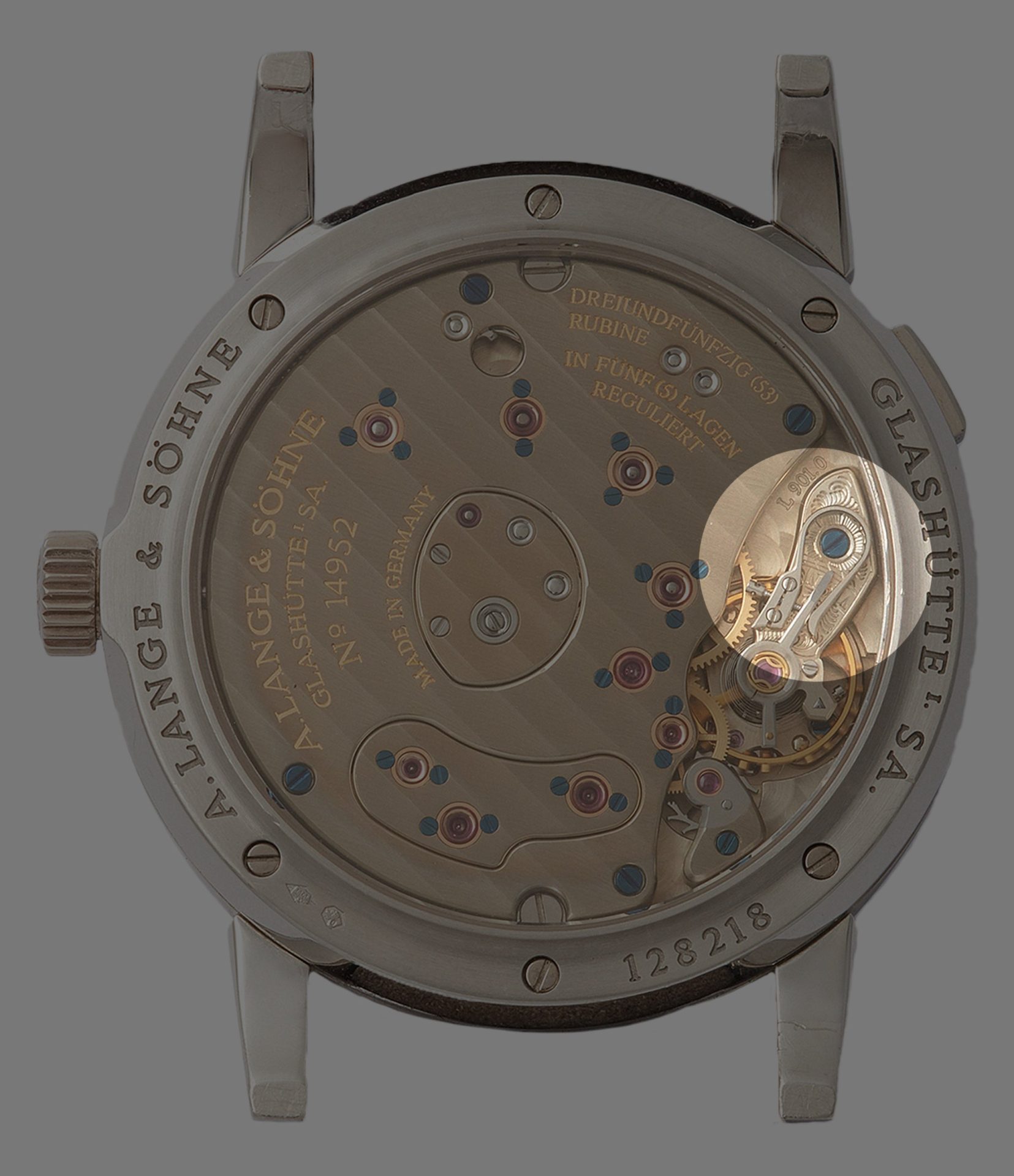
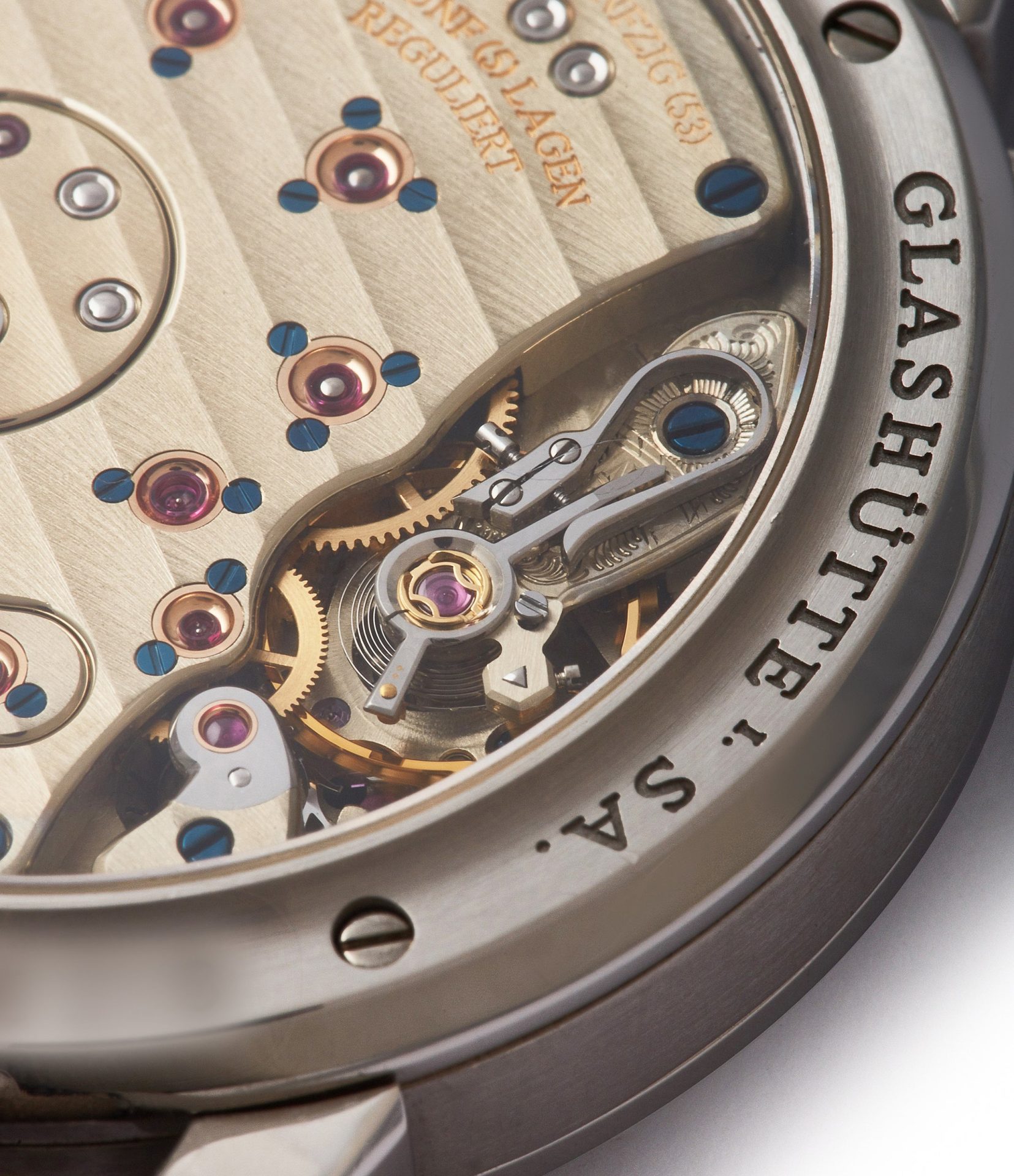
The hand engraved balance cocks of the original L901.0 caliber.
Another individual component of these movements is the aforementioned balance cock. It is said that as they were all hand engraved by one of their master engravers, each with their own intrinsic style, it is possible to walk into the manufacture and for them to tell you exactly who engraved your watch’s balance cock. That’s attention to detail.
The Lange 1 Outliers
By now, we think we’ve made a fairly good case for why the Lange 1, as it was first designed and released in 1994, is worth paying attention to. However, like any good watch family, there are a few special editions, unique pieces and rare collectable varieties that some dedicated collectors can spend years hunting for.
The first that merits drawing attention to is the Lange 1A. It was the first limited edition that A. Lange & Söhne produced for the Lange 1 family, which came out in 1998. Its engine-turned gold dial with golden date window gives this piece a slightly regal feel. If you combine this with the gold balance cock and escape wheel, it turns the watch into a real indulgence for any Lange collector. Only 100 were made, so getting your hands on one can be tricky, although they are known to come to auction every now and then.
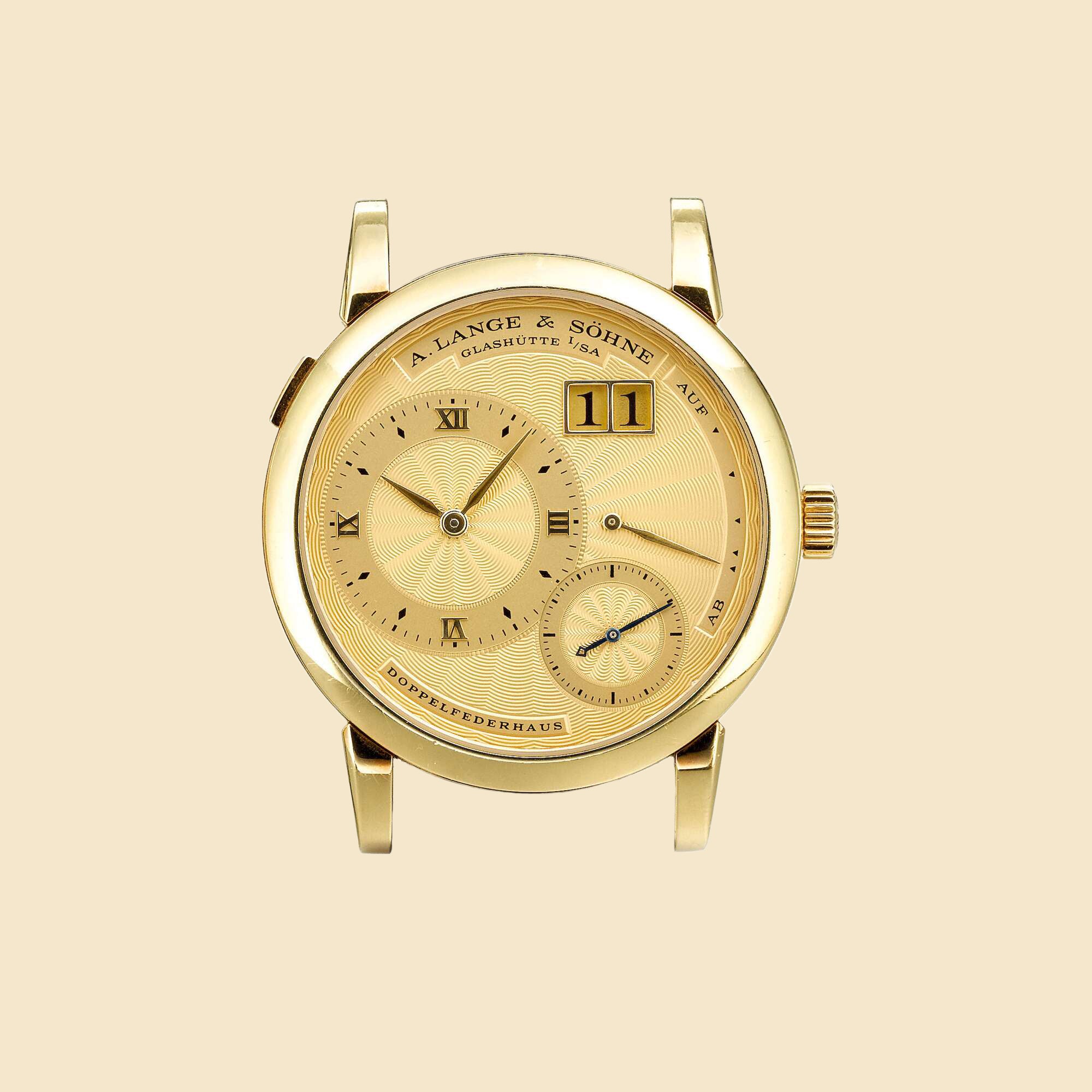
The intricate dial of a Lange 1A, courtesy of Southeby’s
The next variation is not a purposeful limited edition but arises from the fact that Lange changed their production techniques part way through the first run of watches. Something that Alp drew our attention to is the company’s early use of a Breguet overcoil in their L901.0 caliber. This was used in only a handful of the very first pieces that had closed casebacks. As Alp puts it, “there are the closed caseback models, and then there are closed caseback models with a Breguet overcoil. A real grail for Lange collectors.” The reasoning behind the switch so early on, despite being in the middle of a production run, is unclear. However, some believe that it was due to the time-consuming nature of installing such a component.
Another piece which gets quite a lot of attention is the Lange 1 ref 101.028. Though it wasn’t a limited edition per se, it was only produced for a brief period, from around 1998 to 2000. The instantly appealing feature of this reference is its distinctive, dark blue dial. The two subsidiary dials, with the indication for the hours, minutes and seconds, have a slightly darker, even finish. The rest of the dial features a vertical, satin-brushed finish, providing a subtle contrast with the lightly recessed subdials. Often cased in white gold, this dial also appears in a yellow gold case, with the combination being all the more striking. The cult status of this early Lange 1 with a blue dial is such that, in 2017, A. Lange & Söhne released a collection of watches with blue dials, directly inspired by this piece.
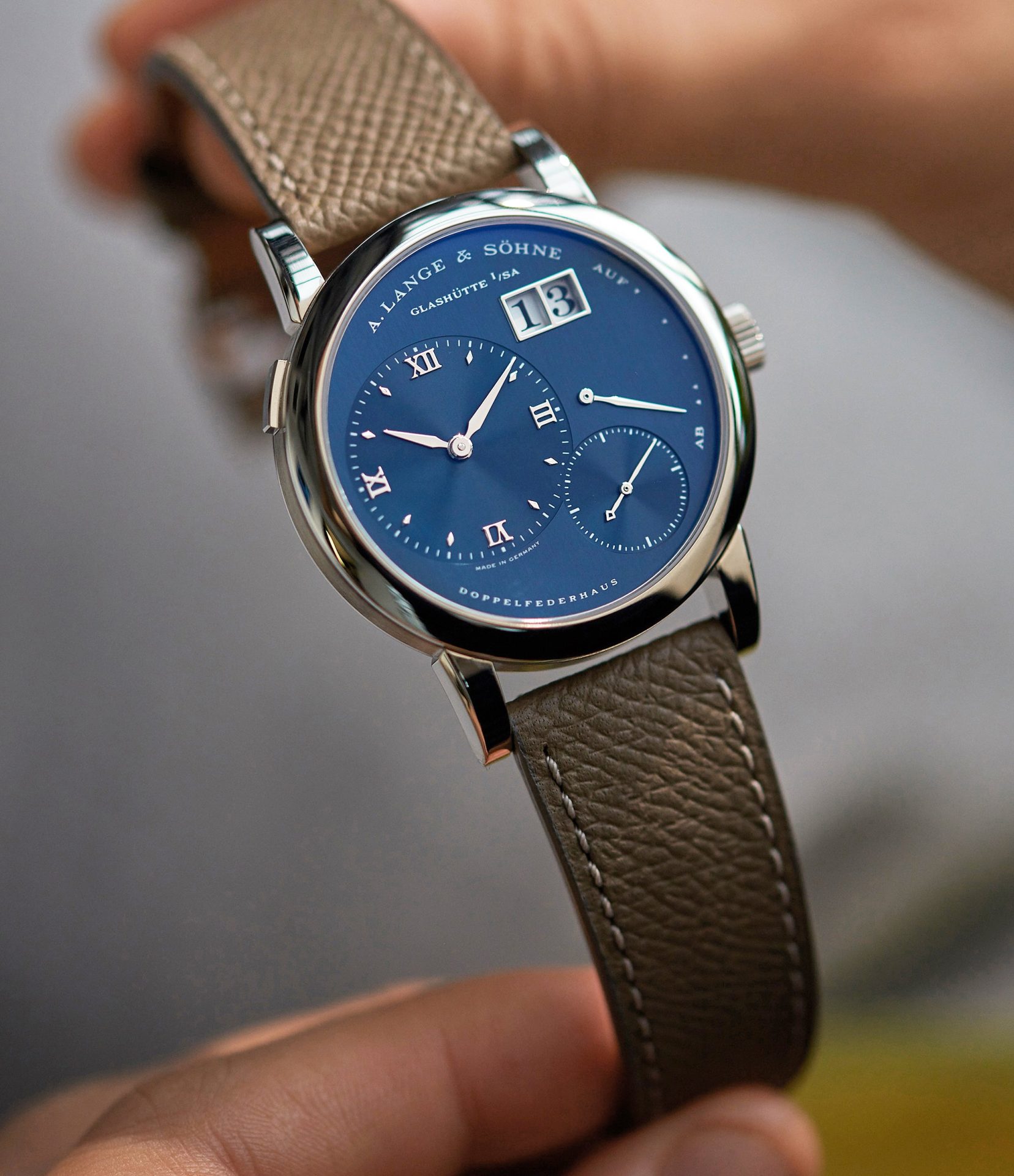
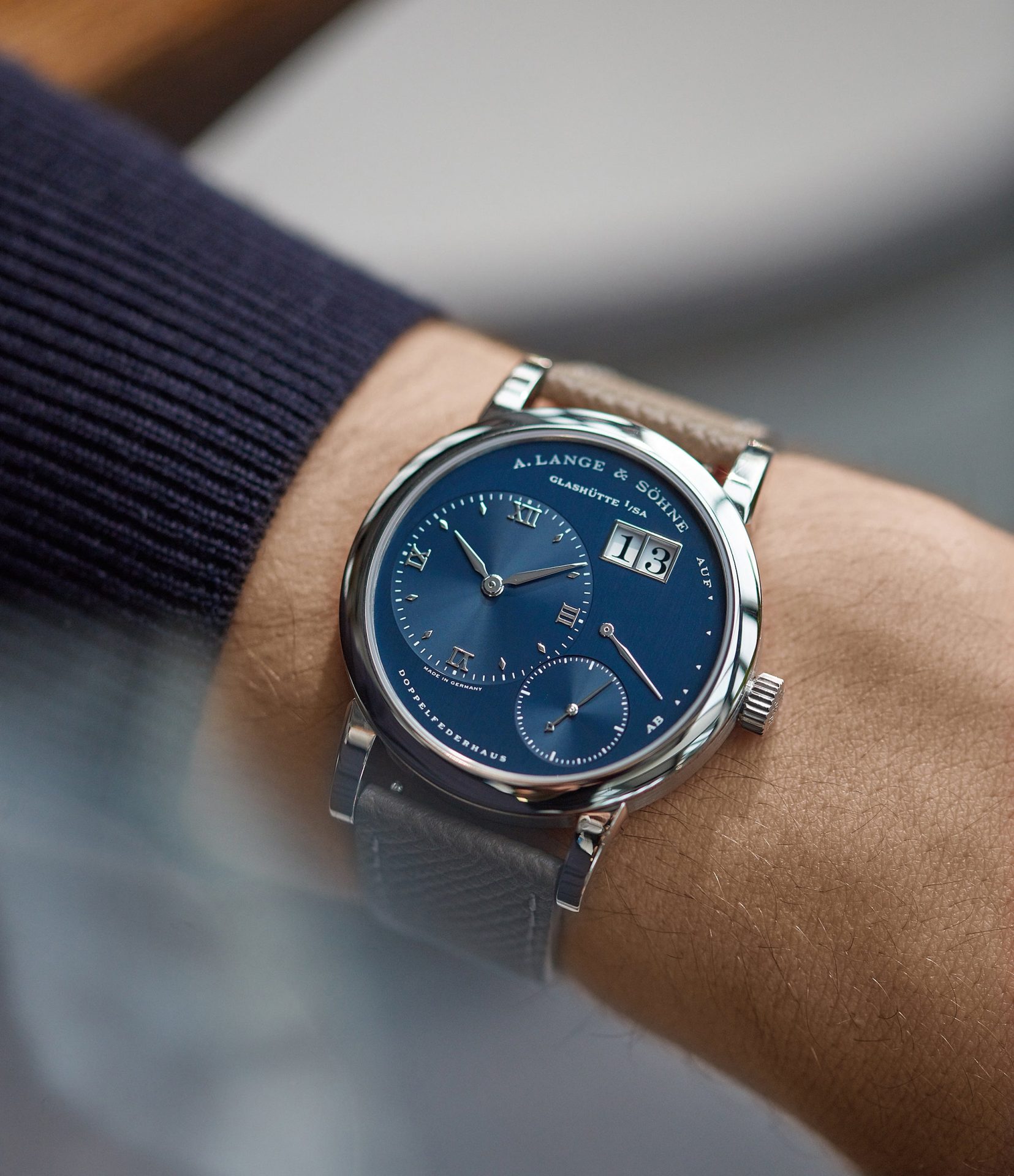
The ever-popular blue dial of a ref 101.027, the white metal version of a ref 101.028
In a continuation of unusual coloured dials, the brand also produced the aptly named “Darth.” The reference 101.035 combines a platinum case, black dial and white-on-black date discs, for a distinctive monochromatic appearance which has deservedly attained a cult status among collectors. Believed to have been produced exclusively between 1999 and 2006, it joins the blue dial above as one of the Lange’s most interesting variants.
This next limited edition is particularly hard to find. The Lange 1 “Floral” ref 112.046 is similar in feel to the Lange 1A, with its hand-engraved solid gold dial. This time, the yellow gold dial is paired with a pink gold case and an engraved caseback that shows the crest of Glashütte. These were sold as part of a set, with a standard 38.5mm version and a smaller 36.5mm, made exclusively for the Japanese market.
This was not the only time that A. Lange & Söhne reduced the size of the Lange 1, with a few smaller models having been produced over the years, aptly referenced as the “Little Lange 1”. First released in 1998, with a diameter of around 36mm, the Little Lange 1 was aimed at markets with smaller wrists, such as Japan. Often confused with women’s watches, as the brand eventually adopted this size for their contemporary female offering, these earlier pieces were actually meant to bring the Lange 1 design to those who preferred the more restrained case size.
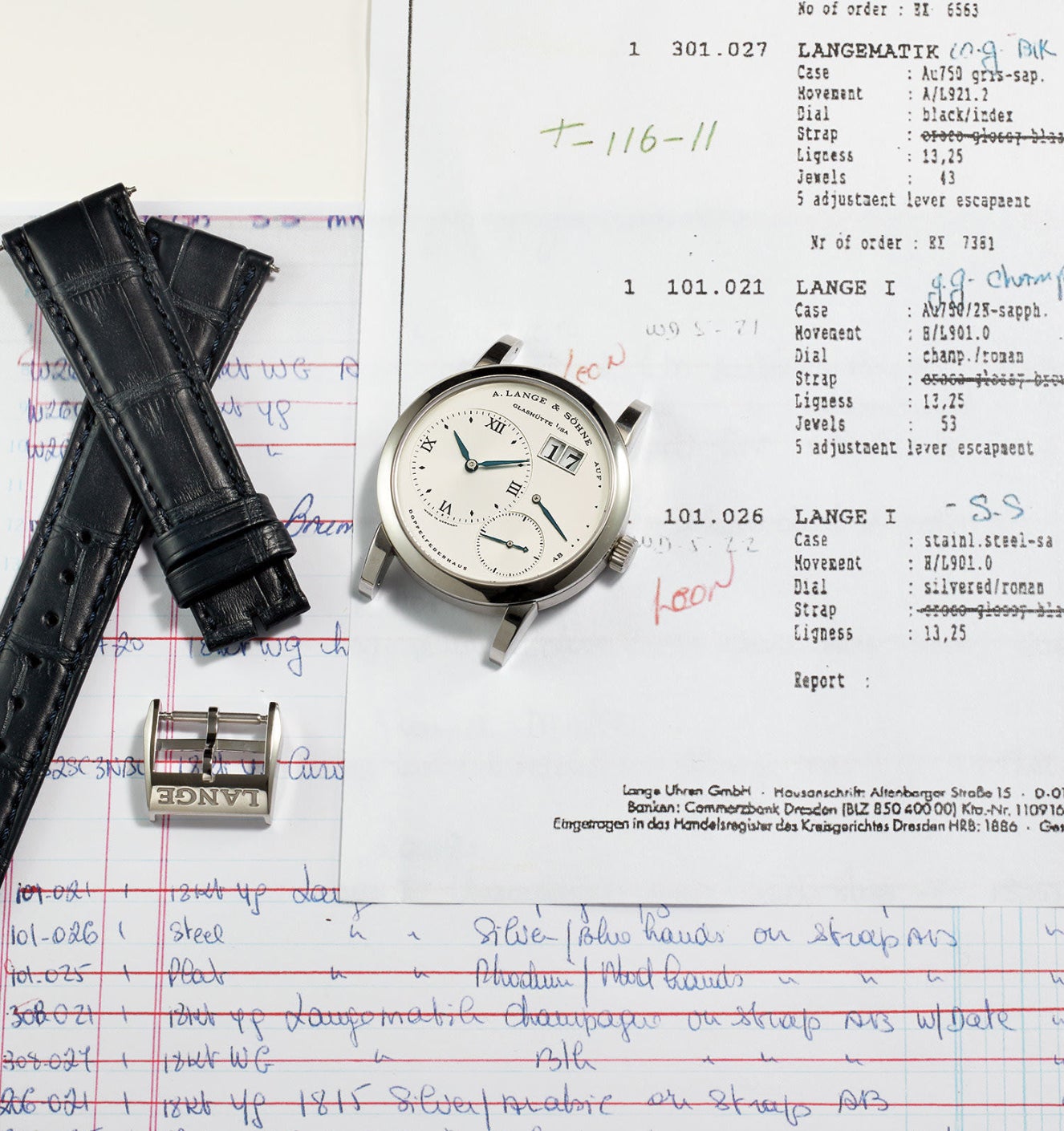
A NOS Lange 1 in steel and perfect condition, courtesy of Phillips.
As is often the case with watches that were originally cast in precious metals, if or when they are released in stainless steel, these models instantly become desirable. This also applies to the Lange 1, where the stainless steel models have developed a cult following. Until the release of the Odysseus in 2019, Lange made precisely zero watches in stainless steel, in any series. There are only a few stainless steel versions out there in the wild, which generate significant attention whenever they come up for auction. Though A. Lange & Söhne has never disclosed the exact number of steel watches that were produced, it is thought that roughly twenty to thirty were made, with only six of these having come up for auction.
They were produced in the company’s first year on demand by special clients or retailers, marking a significant exception to the company’s policy of using precious metals as their material of choice. When you consider this, it makes sense that Ben Clymer of HODINKEE describes the steel Lange 1 as “the most collectible Lange in the world.” A rather special example, that was sold just this year, is one that used to belong to none other than Stefan Muser, the CEO of Dr Crott Auctioneers. Sold at Sotheby’s, this piece had Muser’s full name engraved at the top of the caseback ring, giving this piece some unmistakable provenance.
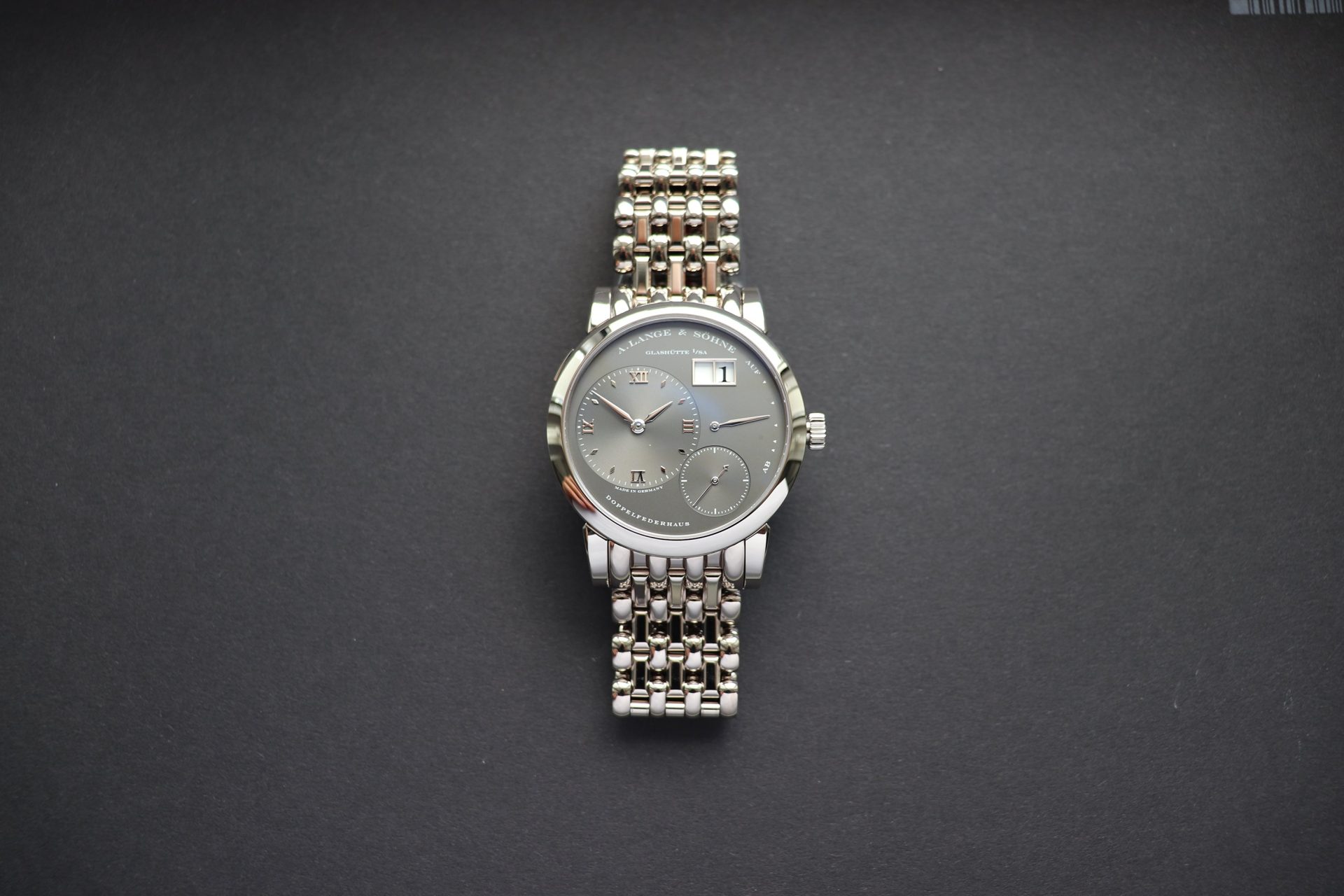
A Lange 1 ref. 101.330 with a rare bracelet and grey dial, courtesy of Langepedia.
Before moving on, it’s worth touching on one final element that doesn’t usually get much attention within the Lange 1 family. Their bracelets. Rarely ever seen, Lange fitted some of their models with bracelets and even produced some Lange 1s with no lugs and an integrated bracelet which sloped directly into the case. Integrated or not, these bracelets came in a range of different designs, from the more classic Milanese and beads of rice, to some much more unusual patterns. It is believed that most of these were made years ago by Wellendorff.
Though their history dates back to 1893, when they were founded by Ernst Alexander and Julie Wellendorff, they unfortunately no long produce watch bracelets, which only adds to their rarity if you do encounter one in the wild. This is somewhat reminiscent of what Patek Philippe used to do back in the day, offering a range of different, unusual bracelet designs, with some of them directly fitted onto their watches, removing the lugs in the process. The fact that Lange pursued this approach, towards the end of the 20th century, only further speaks to their commitment to getting the details right.
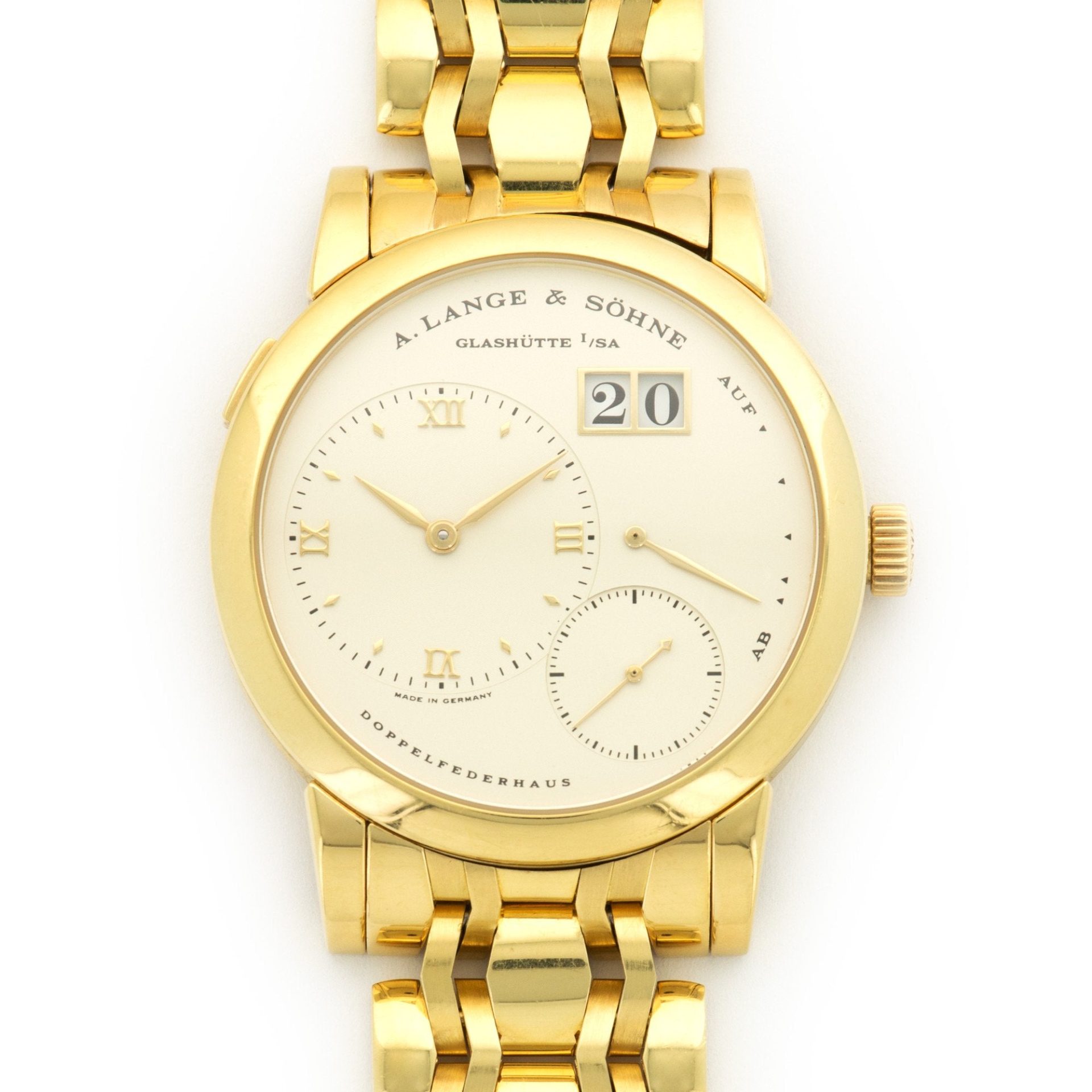
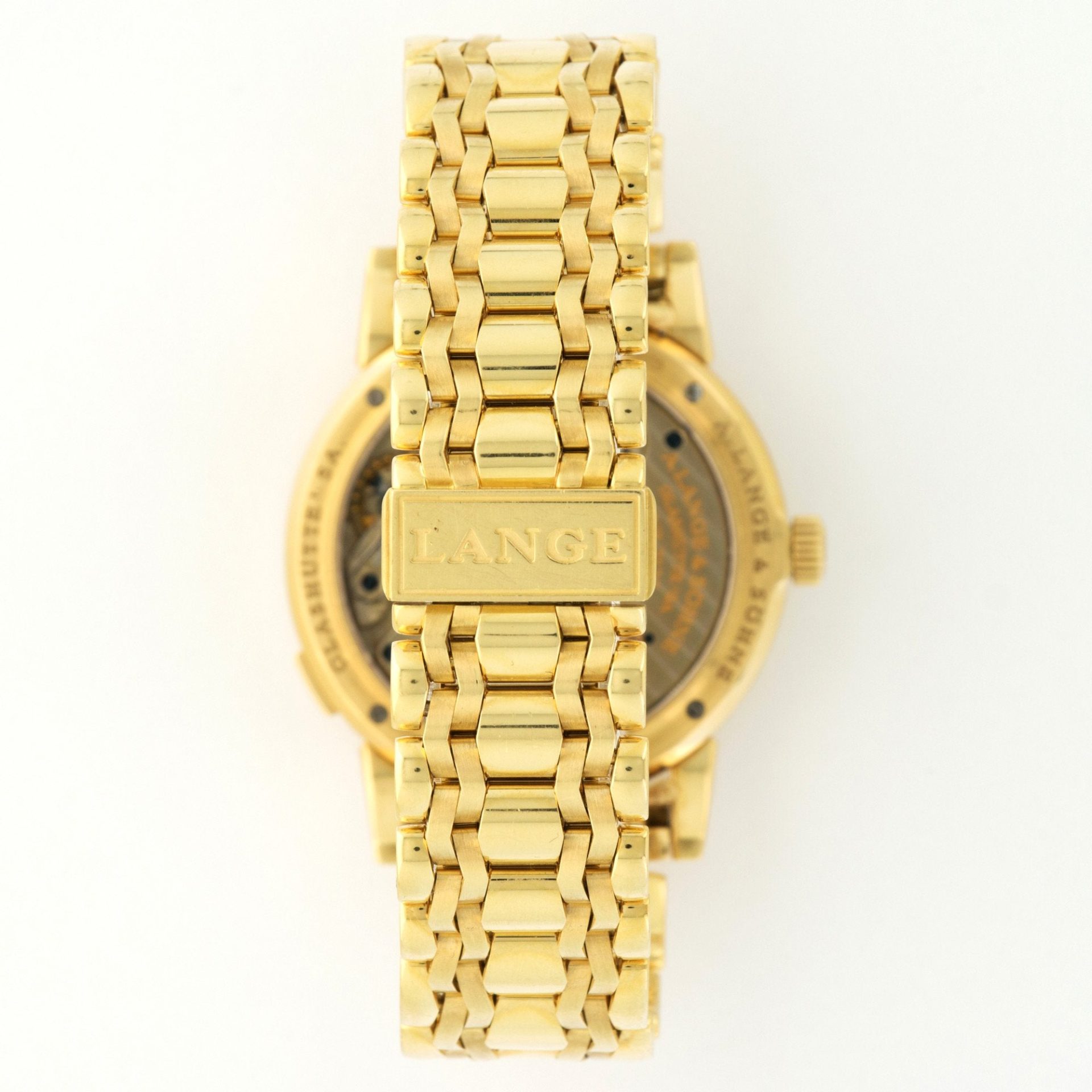
An unusual bracelet on an early Lange 1, courtesy of The Keystone.
The Effect of the Lange 1
It isn’t very often that a watch is released that seems to define a certain area of watchmaking. Very few others come to mind. The Calatrava, the Royal Oak, maybe even the Submariner. Yet none of these, arguably, have done so much for one geographical location of watchmaking as the Lange 1 has. It essentially established a set of design codes for German watchmaking to follow, for over two decades, as well as becoming the “flagship model for the brand,” as Muser states.
There are watches out there that have more complex movements, that are tougher and that can claim more advanced components, however, none seem to have created the perfectly geometrical shadow that the Lange 1 has over a sector of the industry. We don’t want this to come across as wholehearted endorsement of the Lange 1. There are certainly areas in which it’s lacking. What we can say for certain though is that the Lange 1 seems to meet the requirements of a defining watch. It introduced new ways of looking at watchmaking and broadening the horizons of an industry which, at the time, was very focused on the insular community of Switzerland. If that doesn’t elevate this watch to a certain level of greatness, we’re not sure what does.
We would like to thank Alp from Langepedia and Stefan Muser of Dr. Crott Auctioneers for providing their insight to this, now legendary, model.


